Euphorbia Horrida, a distinctive plant, is often mistaken for a cactus due to its spiky look. This common misconception can lead to misunderstandings about its care needs. Unlike typical cacti, the Euphorbia Horrida is part of the Euphorbiaceae family, distinguished by its unique features. Recognizing these characteristics is vital to ensure proper care and thriving growth.
Appearance of Euphorbia Horrida

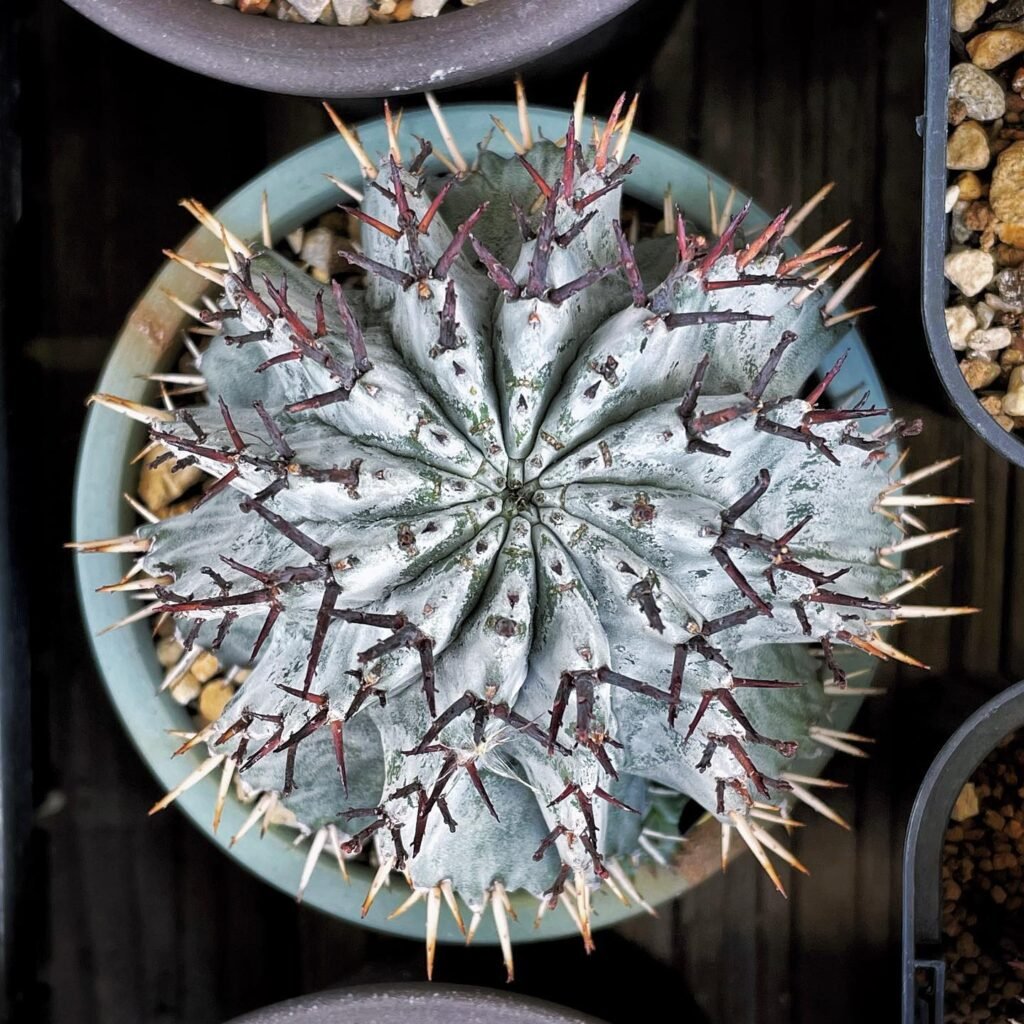
Euphorbia Horrida is a captivating plant with a unique look, characterized by:
- Spiky Appearance: It has ridged stems covered in sharp spines, resembling a cactus.
- Colour: Its colour ranges from greenish-grey, often with subtle variegations.
- Growth Pattern: The stems grow upright, sometimes forming clusters.
- Distinctive Texture: Its rough texture adds to its rugged charm.
This plant’s fascinating appearance makes it a standout choice for gardens or as an indoor feature, bringing a touch of the exotic to any setting.
Light Requirements for Euphorbia Horrida


When it comes to light, Euphorbia Horrida has its preferences:
- Love for Brightness: This plant is happiest in bright, indirect sunlight. Think of a sunny spot where the light is generous but softened, perhaps by a sheer curtain.
- Beware of Direct Sun: Although it likes light, direct sun can be too harsh, leading to sunburn. It’s like enjoying a sunny day but with a hat on.
- Indoors? Near a Window: If you’re growing it inside, a window that bathes it in filtered sunlight is your best bet.
- Outdoors? Think Semi-Shade: If it’s outdoors, choose a spot where it can bask in partial shade, especially in warmer climates.
Remember, getting the light right with Euphorbia Horrida is a bit like finding the perfect spot to read a book – not too dark, not too bright.

Watering Tips for Euphorbia Horrida
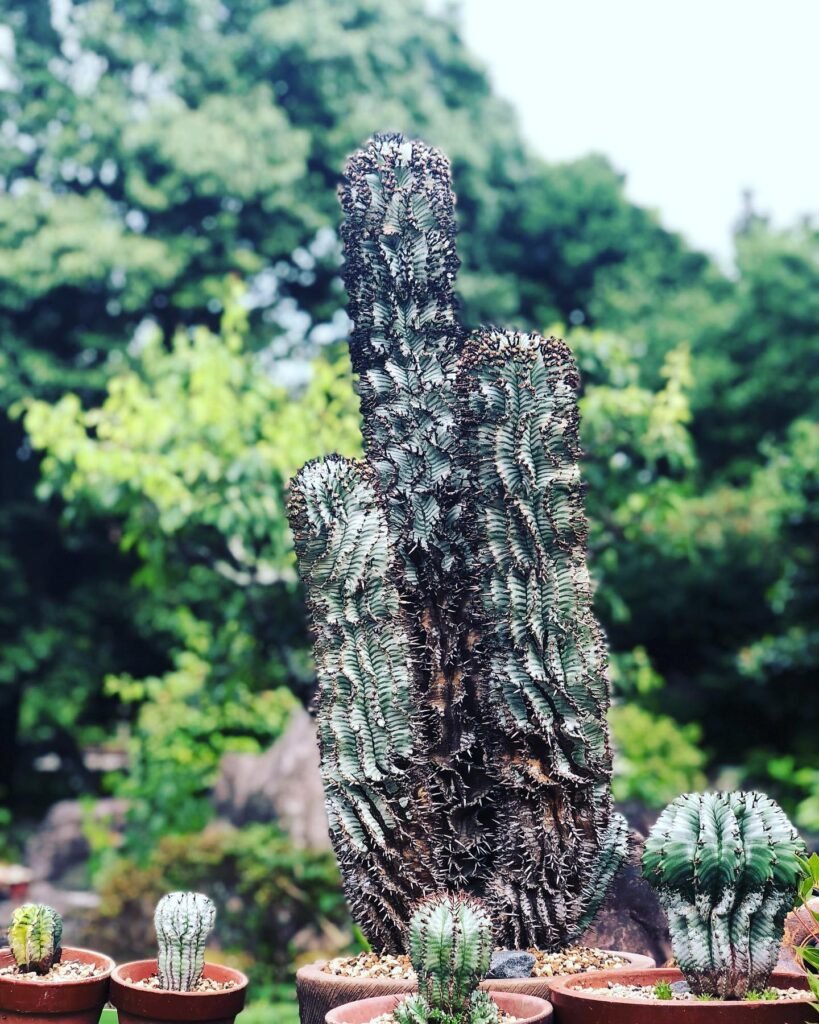
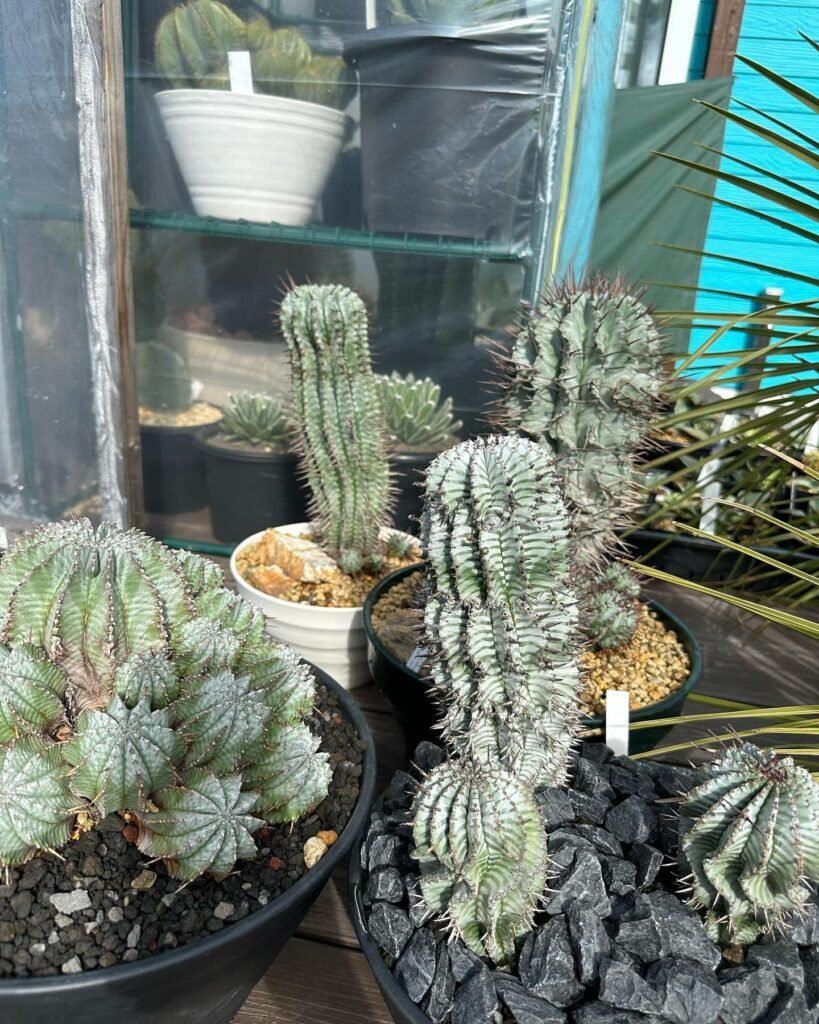
Understanding the watering needs of Euphorbia Horrida is key to its care. This plant prefers a balance, avoiding both over and under-watering:
- Frequency: Typically, watering every 1-2 weeks is adequate. However, this can vary based on environmental factors. In warmer, sunnier conditions, the soil dries out faster, possibly requiring more frequent watering.
- Check the Soil: Before watering, check the top inch of soil. If it’s dry, it’s time to water. If it’s still moist, wait a bit longer.
- Winter Care: During winter, when the plant enters a dormant phase, reduce watering. The cooler temperatures and reduced light mean the plant uses less water.
- Watering Technique: When you water, do it thoroughly. Ensure the water reaches the roots but avoid waterlogging the soil. Excess water should be able to drain away easily.
- Signs of Over/Under-Watering: Overwatering can lead to root rot, indicated by yellowing leaves. Under-watering, on the other hand, will cause the plant to dry out and wilt.

Fertilizing and Soil for Euphorbia Horrida
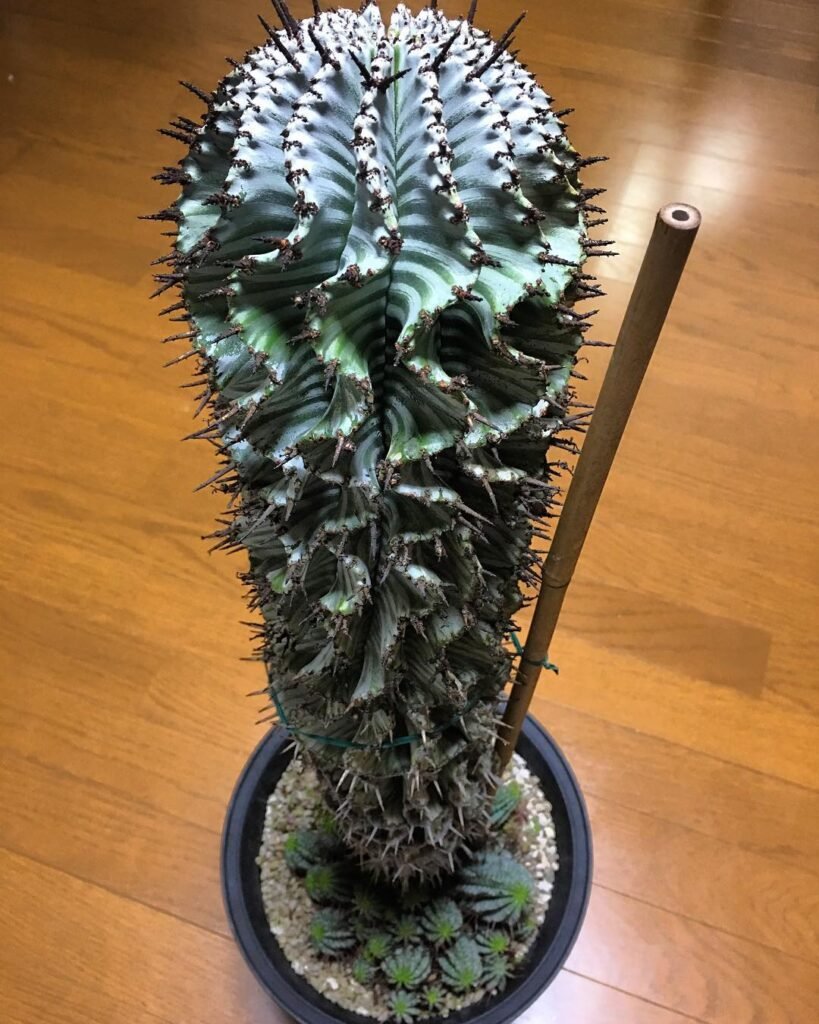

For those new to gardening, getting the soil and fertilization right for Euphorbia Horrida is straightforward but important. Here’s a more detailed guide:
Soil: Choose a well-draining mix, like those specifically made for cacti or succulents. This type of soil helps prevent water from sitting around the roots, which could cause rot.
Fertilizing in Growing Season: In spring and summer, the plant grows more actively. During these months, use a balanced, water-soluble fertilizer, but dilute it to half the strength suggested on the package. Once a month is enough. This gentle approach provides the nutrients the Euphorbia Horrida needs without the risk of overfeeding, which can be harmful.
Fertilizing in Dormant Season: In autumn and winter, the plant takes a break. Its growth slows down, so it doesn’t need as much food. That’s why you should stop fertilizing during these months.
Remember, the key is not to overdo it. Just like with other aspects of care, Euphorbia Horrida doesn’t need intense feeding. A little goes a long way. With the right soil and a careful, measured approach to fertilizing, your Euphorbia Horrida will have a solid foundation to flourish.

Pruning and Maintenance for Euphorbia Horrida

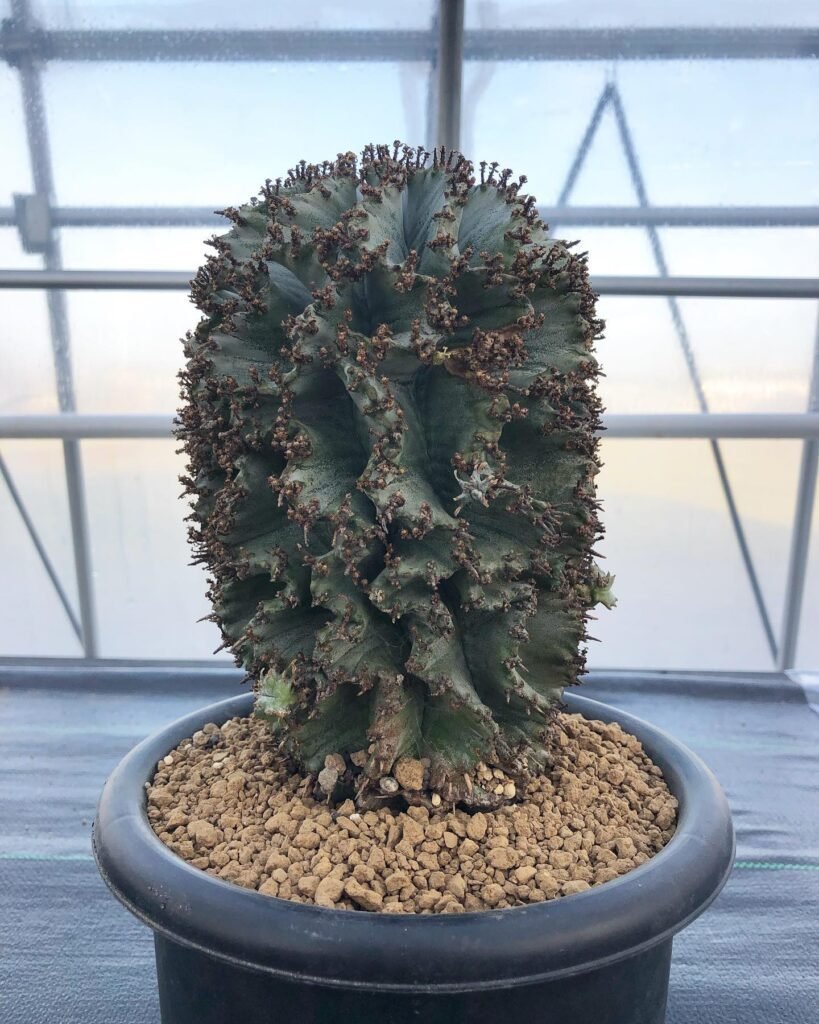
Maintaining Euphorbia Horrida is quite simple and involves regular checks and minimal pruning. Here’s what you need to do:
- Regular Checks: Inspect your plant frequently for any signs of unhealthy or damaged parts.
- Pruning Basics: Use clean, sharp tools for pruning. Remove any dead or unhealthy stems or leaves to keep the plant looking its best and to encourage healthy growth.
- When to Prune: The best time to prune is during the spring, as the plant enters its growth phase.
- Disposing of Waste: Safely dispose of the pruned parts, especially since the sap can be irritating.
By following these steps, you’ll keep your Euphorbia Horrida in great shape, ensuring it remains a beautiful and healthy addition to your garden. Remember, a little regular attention goes a long way!

Propagating Euphorbia Horrida


Propagating Euphorbia Horrida is a straightforward and enjoyable process. It allows you to create new plants from your existing one. Here’s how to do it:
- Select a Healthy Stem: Choose a firm, undamaged stem around 5-10 cm long.
- Safety First: Wear gloves to protect yourself from the plant’s sap.
- Making the Cut: Use clean, sharp scissors or a knife for the cut.
- Drying Out: Let the stem dry for a few days to form a callus, essential for rooting.
- Planting: Plant the dried stem in well-draining soil.
- Light Watering: Water the cutting lightly and avoid over-watering.
This process is not just about growing a new plant; it’s about observing and learning the growth cycle of Euphorbia Horrida. With patience and care, you’ll see the rewards of your effort as new growth emerges.

Repotting Tips for Euphorbia Horrida
Repotting Euphorbia Horrida is simpler than it seems, especially with these easy-to-follow steps:
- Selecting the Right Pot: Look for a pot with drainage holes to prevent excess water.
- Best Repotting Time: Spring is the ideal season for repotting, as the plant starts its growth.
- Handling the Roots: Gently remove the plant from its current pot, being cautious with the roots.
- Using Fresh Soil: Opt for well-draining soil, suitable for succulents or cacti.
- Plant Positioning: Place your plant in the new pot at the same soil depth as before.
- Initial Watering: Water the plant lightly after repotting, but avoid fertilizing right away.
 Euphorbia Horrida is known as ‘African Milk Barrel’ for its cylindrical shape. This intriguing plant is a succulent, not a cactus, despite its spiny appearance, and it exudes a milky sap when cut.
Euphorbia Horrida is known as ‘African Milk Barrel’ for its cylindrical shape. This intriguing plant is a succulent, not a cactus, despite its spiny appearance, and it exudes a milky sap when cut.
Benefits of Growing Euphorbia Horrida
Growing Euphorbia Horrida offers several advantages:
- Air Purification: It helps purify the air in your home, making your environment healthier.
- Easy Care: Its low-maintenance nature is ideal for busy or novice gardeners.
- Aesthetic Appeal: The unique, spiky appearance adds an exotic touch to any space.
- Mental Wellbeing: Caring for it can be a relaxing and rewarding hobby.
- Space Flexibility: It’s versatile for both indoor and outdoor settings.
These benefits make Euphorbia Horrida a wonderful plant choice, offering both visual beauty and practical perks.
Videos about Growing Euphorbia Horrida
We’ve chosen some top-notch videos for you. They’re all about looking after Euphorbia Horrida and showing off other people’s lovely collections. These videos make it easy to learn, showing you step-by-step how to care for your plant. They’re great for beginners and a fantastic way to see how others enjoy this plant in their own spaces.
- ‘My Euphorbia horrida Succulent Plant in Flower | African Milk Barrel’
- Euphorbia Plant Care and Collection
Euphorbia Horrida Easy Care and Growth FAQs

For all the green thumbs and budding gardeners out there, here’s a detailed FAQ section on Euphorbia Horrida. We’ve gathered a range of questions from basic care to troubleshooting problems, all designed to be easy to understand for beginners. Let’s dive in!
Euphorbia Horrida thrives in well-draining, sandy soil. A cactus or succulent mix works perfectly.
Yes, it loves bright, indirect sunlight. A sunny windowsill is an ideal spot.
Yes, but it’s best in warm climates and should be brought indoors in cooler temperatures.
Gently transfer it to a slightly larger pot with fresh, well-draining soil. Handle carefully to avoid damage.
Yes, it can be. Keep it out of reach of pets and children.
Signs of overwatering include yellowing leaves and a mushy stem.
Yellow leaves usually mean too much water or not enough light. Adjust care accordingly.
It can survive, but it won’t thrive. It prefers bright, indirect light.
Use cuttings and let them callous before planting in soil.
Watch out for mealybugs and spider mites, and treat them with appropriate insecticides.
It’s a slow grower, so don’t worry if you don’t see rapid changes.
Indoors, it typically grows up to 2-3 feet tall.
This could be due to temperature stress, overwatering, or under-watering. Check your care routine and adjust as needed.
Water only when the soil is completely dry. Overwatering can harm the plant.
I hope these FAQs help you on your gardening journey with Euphorbia Horrida. If you’ve got more questions or need a bit more guidance, feel free to drop them in the comments. I’ll do my best to answer them and help your Euphorbia Horrida flourish!





